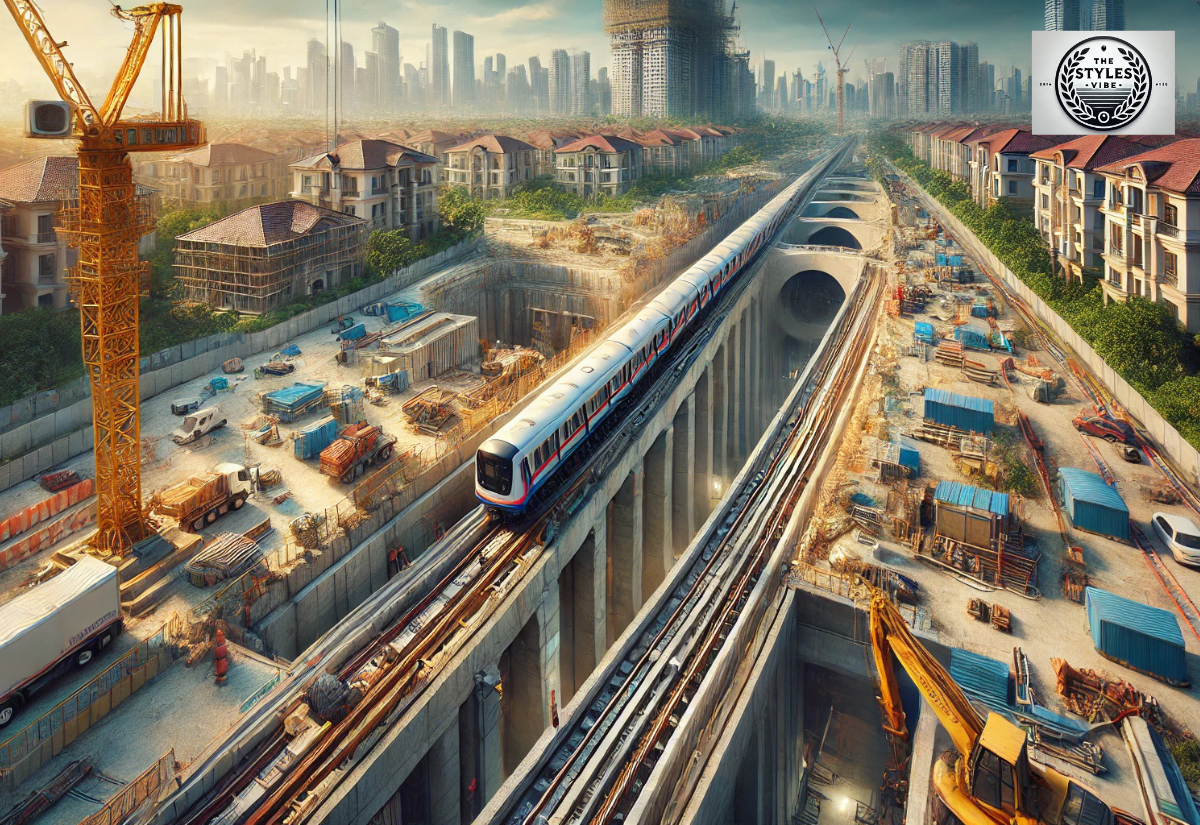Introduction
Overview Of The Metro Manila Subway Project (mmsp)
The Metro Manila Subway Project (MMSP) is the first underground railway system in the Philippines. It is a massive infrastructure project under the government’s “Build, Build, Build” program. The subway will cover 33 kilometers and include 17 stations, connecting Valenzuela City in the north to the Ninoy Aquino International Airport in the south. The subway’s route will pass under Corinthian Village in Quezon City, making it a key part of the project. The MMSP is designed to improve public transportation, offering faster and more efficient travel for Metro Manila residents.
Significance Of The Subway In Addressing Metro Manila’s Traffic Congestion
Metro Manila is known for heavy traffic, with millions of vehicles clogging the roads daily. Commuters often spend hours traveling between home and work. The Metro Manila Subway aims to solve this problem by providing an alternative transport system that is fast, reliable, and efficient. With trains running underground, the subway will reduce the number of cars on the road and ease traffic congestion in key areas. For residents of Corinthian Village, the subway will provide easy access to business districts, schools, and other important locations, making daily travel quicker and more convenient. This project is a major step toward solving Metro Manila’s traffic issues and improving the quality of life for its people.
Metro Manila Subway Project Overview
Project Inception And Timeline
The Metro Manila Subway Project began as part of the Philippine government’s “Build, Build, Build” program, aiming to solve Metro Manila’s worsening traffic problems. Officially approved in 2017, the project started with its groundbreaking ceremony in February 2019. The subway will run across 33 kilometers, covering 17 stations. The alignment is designed to connect key areas, such as business hubs, residential zones, and airports, for efficient travel. The subway’s route under Corinthian Village is a strategic decision, ensuring seamless travel through densely populated areas. The government plans to open three stations by 2027, with full operations expected by 2028.
Key Stakeholders And Funding Sources
The Metro Manila Subway is funded through a partnership with the Japan International Cooperation Agency (JICA), which provided a loan of PHP 355.6 billion for the project. JICA’s financial support ensures the subway uses advanced Japanese technology for construction and operations. The Department of Transportation (DOTr) manages the project and coordinates with Japanese contractors and engineers for equipment, such as tunnel boring machines (TBMs). This collaboration ensures safety and efficiency in construction. Local contractors are also part of the project, generating jobs and ensuring community involvement throughout the process.
Current Status And Projected Completion Dates
The Metro Manila Subway is currently in its construction phase. Tunnel boring machines have been delivered, and initial tunneling work has started in several areas, including the section under Corinthian Village. Engineers and contractors are focusing on minimizing disruptions to residents by using advanced underground construction methods. The project is set to partially operate by 2027, starting with three stations: East Valenzuela, Quirino Highway, and Tandang Sora. Full completion, covering all 17 stations from Valenzuela to the Ninoy Aquino International Airport, is targeted for 2028. These milestones aim to deliver faster and more reliable transport for Metro Manila commuters.
Route And Alignment Details
General Route Of The Subway
The Metro Manila Subway will run 33 kilometers across several key cities in Metro Manila. It will connect Valenzuela City in the north to Ninoy Aquino International Airport in the south. The subway will pass through major areas like Quezon City, Pasig, Makati, Taguig, and Parañaque. There will be 17 stations along the route, placed in locations that serve as transportation hubs, business districts, and residential communities. This design ensures that the subway will improve connectivity and reduce travel time for commuters. The route was carefully planned to cover areas with high demand for public transportation, addressing traffic congestion in Metro Manila.
Specific Alignment Passing Under Corinthian Village
A significant part of the subway’s route is its alignment under Corinthian Village, a prominent residential area in Quezon City. This decision was made to connect important locations without disrupting the above-ground environment. The subway will pass deep underground to avoid affecting the homes and streets in Corinthian Village. The engineers and planners ensured that the alignment under this area meets safety and efficiency standards. Residents of Corinthian Village will benefit from improved accessibility once the subway is operational, as it will provide faster connections to business and commercial areas in Metro Manila.
Technical Aspects Of Tunneling In Residential Areas
The construction of the Metro Manila Subway under Corinthian Village uses advanced tunneling methods to minimize disturbances. Tunnel boring machines (TBMs) are used for precise underground digging, reducing noise and vibration at the surface. Engineers perform regular assessments to ensure that buildings and infrastructure above the tunnels remain safe. Special techniques are applied to control ground movement and prevent structural damage to homes in Corinthian Village. The depth of the tunnels is calculated to avoid interference with utilities and foundations. These measures ensure that the subway can pass under residential areas safely and efficiently.
Impact On Corinthian Village
Potential Effects On Residents During Construction
The construction of the Metro Manila Subway under Corinthian Village may bring some challenges for residents. Noise from machinery and equipment could be noticeable at times. Vibrations during the tunneling process might also raise concerns, especially for homes and buildings located above the planned route. Increased movement of construction vehicles near Corinthian Village might temporarily affect traffic flow in the area. Residents may also experience limited access to certain utilities if adjustments are needed to accommodate the underground construction work. These effects, however, are being managed with strict safety protocols to protect the community.
Measures Taken To Mitigate Disruptions
The construction team has implemented several measures to reduce disruptions for Corinthian Village residents. Tunnel boring machines (TBMs) are being used to dig underground efficiently, creating less noise and vibration compared to traditional methods. Work schedules are planned to avoid peak hours, minimizing disturbances to daily activities. Engineers and planners ensure regular communication with residents, informing them about construction updates and addressing concerns. Safety inspections are conducted regularly to monitor the structural stability of homes and buildings. The project also includes noise barriers and vibration-dampening systems to keep the impact as minimal as possible.
Long-term Benefits For The Community
The Metro Manila Subway will bring significant benefits to Corinthian Village residents once completed. Travel will become faster and easier, with shorter commute times to key areas like business districts and airports. Property values in Corinthian Village are expected to increase due to improved connectivity and infrastructure. The subway will also reduce the number of cars on the road, leading to less traffic congestion around the area. Overall, the project will enhance the quality of life for residents by providing modern, efficient transportation while boosting the local economy and community development.
Engineering And Construction Challenges
Geological And Structural Considerations
The Metro Manila Subway faces several challenges due to the geological and structural conditions in the city. Metro Manila’s soil composition includes clay, sand, and rock, which require careful assessment to ensure safe tunneling. The subway’s alignment under Corinthian Village adds complexity because the area is residential, and its foundations must remain intact. Engineers study the ground conditions to prevent soil shifting during construction. The depth of the tunnels is carefully calculated to avoid damaging underground utilities and the foundations of buildings above. These geological considerations are essential to ensure the subway’s stability and safety.
Use Of Tunnel Boring Machines (TBMs) And Other Technologies
Tunnel Boring Machines (TBMs) are the primary tools used for building the Metro Manila Subway. These machines are designed to dig tunnels with precision while minimizing noise and vibration on the surface. The TBMs create smooth, circular tunnels, which ensure the subway’s structural integrity. Advanced monitoring systems are installed to track the progress and detect any issues during tunneling. Other technologies, such as real-time mapping and ground reinforcement systems, help ensure that the subway passes safely under Corinthian Village and other residential areas. These innovations make the construction process faster and safer.
Safety Protocols And Standards In Urban Tunneling
Safety is a top priority in the construction of the Metro Manila Subway, especially in urban areas like Corinthian Village. Engineers follow strict international standards for urban tunneling to prevent accidents. The tunnels are reinforced with concrete segments to ensure durability. Regular inspections are conducted to monitor the impact of construction on nearby buildings and infrastructure. Emergency response systems are in place to address any issues quickly. Noise and vibration levels are controlled to reduce disturbances for residents. These safety measures ensure that the subway project progresses smoothly while protecting the community.
Community Engagement And Public Consultation
Efforts By The Department Of Transportation (dotr) To Inform And Involve Residents
The Department of Transportation (DOTr) has taken steps to involve the community in the Metro Manila Subway Project. Public meetings and consultations are held to explain the project, including the section that will pass under Corinthian Village. Residents are informed about the construction process, potential impacts, and benefits of the subway. The DOTr shares updates through newsletters, online platforms, and community bulletins. These efforts aim to keep the community well-informed and prepared for the changes that the subway construction may bring. By involving residents, the DOTr builds trust and ensures transparency throughout the project.
Feedback Mechanisms And Grievance Redressal
The DOTr has set up systems to gather feedback and address concerns from residents. Hotlines, email addresses, and dedicated community representatives are available for residents to share their questions or complaints. Regular surveys are conducted to understand the needs and expectations of the community. If any issues arise during construction, such as noise or vibration disturbances, residents can report them through these channels. The DOTr ensures that every concern is addressed quickly and fairly. This feedback system helps in resolving conflicts and maintaining good relationships with the community.
Role Of Local Government Units In Facilitating Communication
Local government units (LGUs) play a key role in supporting the Metro Manila Subway Project. In areas like Corinthian Village, LGUs help bridge communication between the DOTr and residents. They organize local meetings and provide updates to the community. LGUs also help enforce safety and environmental regulations during construction. By working closely with the DOTr, local officials ensure that the project aligns with the needs of the community. Their involvement strengthens the connection between the government and residents, making the subway construction process smoother and more efficient.
Comparative Analysis With Other Urban Subway Systems
Lessons Learned From International Subway Projects
The Metro Manila Subway Project draws inspiration from successful subway systems around the world. Projects in countries like Japan, Singapore, and Hong Kong provide valuable lessons in efficiency, safety, and reliability. Japan’s subway systems, such as the Tokyo Metro, are known for their punctuality and advanced technology. Singapore’s MRT system demonstrates how effective urban planning can create a seamless public transport network. Hong Kong’s MTR shows the importance of integrating subways with other transportation systems. These international projects highlight the need for precise engineering, community involvement, and long-term planning, all of which are applied to the Metro Manila Subway.
Adaptation Of Global Best Practices To The Metro Manila Context
The Metro Manila Subway Project uses global best practices while considering local challenges and needs. Advanced tunnel boring machines (TBMs), similar to those used in Japan, are employed to construct the tunnels under areas like Corinthian Village safely. Noise and vibration control measures, inspired by international standards, ensure minimal disturbance to residents. Urban planning principles from cities like Singapore guide the integration of the subway with other transport systems, such as buses and trains. The project also focuses on adapting designs to Metro Manila’s unique conditions, including heavy traffic and dense populations, ensuring a subway system that is effective, modern, and suitable for the Philippines.
Future Prospects And Connectivity
Integration With Existing And Planned Transport Networks
The Metro Manila Subway is designed to connect with other public transport systems, creating a seamless network for commuters. It will integrate with existing train lines like the MRT-3, LRT-1, and LRT-2, as well as the upcoming North-South Commuter Railway. Key stations, such as those near business districts and residential areas like Corinthian Village, will act as hubs for transferring between systems. This integration ensures that commuters can travel across Metro Manila easily, reducing their reliance on private vehicles and making public transport more convenient.
Expected Improvements In Commute Times And Urban Mobility
The Metro Manila Subway will significantly reduce commute times for residents. For example, traveling from Quezon City to the airport, which usually takes over an hour by car, will take only 35 minutes on the subway. For those living near Corinthian Village, this will mean faster access to business districts, schools, and commercial areas. The subway will ease congestion on major roads, improving urban mobility for everyone. By providing a faster and more reliable transport option, it will make daily commutes less stressful and more efficient for Metro Manila residents.
Potential For Economic Development And Property Value Appreciation
The Metro Manila Subway is expected to boost economic growth in areas near its route. It will create jobs during construction and improve access to businesses, encouraging investments and tourism. Properties close to subway stations, including those near Corinthian Village, are likely to increase in value due to better connectivity. Improved infrastructure often attracts new developments, such as malls, offices, and housing projects, which will benefit the community. The subway will not only enhance transportation but also contribute to the long-term economic development of Metro Manila.
Conclusion
The Metro Manila Subway is a groundbreaking project that promises to transform public transportation in the Philippines. Its route, which includes passing under Corinthian Village, shows careful planning and attention to urban needs. The subway will reduce traffic congestion, improve commute times, and connect key areas in Metro Manila. For residents of Corinthian Village, the subway brings faster travel and increased property value, making it a valuable addition to the community.
With advanced construction methods and international best practices, the project ensures safety and minimal disruption for residents. Efforts by the Department of Transportation (DOTr) and local governments have helped involve the community in the process, building trust and understanding. The integration of the subway with other transport networks will make traveling in Metro Manila faster, easier, and more convenient.
FAQs
1. Why Is The Metro Manila Subway Passing Under Corinthian Village?
The alignment under Corinthian Village was chosen for its strategic location, connecting key areas in Metro Manila efficiently. It ensures minimal surface disruption while providing faster access to important districts, benefiting both residents and the larger community.
2. How Will The Subway Construction Affect Residents Of Corinthian Village?
During construction, residents might experience some noise and vibration, but advanced tunneling technologies like Tunnel Boring Machines (TBMs) are being used to minimize these impacts. The Department of Transportation (DOTr) is implementing safety measures and keeping residents informed throughout the process.
3. What Safety Measures Are In Place For The Subway Construction Under Corinthian Village?
The construction follows strict international safety standards. Regular inspections ensure structural stability, and vibration control systems are in place to protect homes and infrastructure. The tunnels are built at a depth designed to avoid affecting buildings and utilities.
4. What Benefits Will Corinthian Village Residents Gain From The Metro Manila Subway?
Once operational, residents will have faster and more convenient access to business districts, commercial areas, and transport hubs. Property values in Corinthian Village are also expected to increase due to improved connectivity and infrastructure.
5. When Will The Metro Manila Subway Be Completed, And How Long Will It Take To Operate Fully?
The Metro Manila Subway is expected to start partial operations by 2027, with the first three stations opening. Full operations, including the segment under Corinthian Village, are projected to be completed by 2028.




